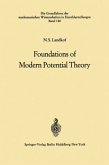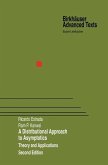Oliver Dimon Kellogg
Foundations of Potential Theory
Oliver Dimon Kellogg
Foundations of Potential Theory
- Broschiertes Buch
- Merkliste
- Auf die Merkliste
- Bewerten Bewerten
- Teilen
- Produkt teilen
- Produkterinnerung
- Produkterinnerung
The present volume gives a systematic treatment of potential functions. It takes its origin in two courses, one elementary and one advanced, which the author has given at intervals during the last ten years, and has a two-fold purpose: first, to serve as an introduction for students whose attainments in the Calculus include some knowledge of partial derivatives and multiple and line integrals; and secondly, to provide the reader with the fundamentals of the subject, so that he may proceed immediately to the applications, or to the periodical literature of the day. It is inherent in the nature…mehr
Andere Kunden interessierten sich auch für
![Seminar on Potential Theory II Seminar on Potential Theory II]() Seminar on Potential Theory II20,99 €
Seminar on Potential Theory II20,99 €![On Topologies and Boundaries in Potential Theory On Topologies and Boundaries in Potential Theory]() Marcel BrelotOn Topologies and Boundaries in Potential Theory20,99 €
Marcel BrelotOn Topologies and Boundaries in Potential Theory20,99 €![Romanian-Finnish Seminar on Complex Analysis Romanian-Finnish Seminar on Complex Analysis]() Romanian-Finnish Seminar on Complex Analysis39,99 €
Romanian-Finnish Seminar on Complex Analysis39,99 €![Foundations of Modern Potential Theory Foundations of Modern Potential Theory]() Naum S. LandkofFoundations of Modern Potential Theory100,99 €
Naum S. LandkofFoundations of Modern Potential Theory100,99 €![Integral Equations with Difference Kernels on Finite Intervals Integral Equations with Difference Kernels on Finite Intervals]() Lev A. SakhnovichIntegral Equations with Difference Kernels on Finite Intervals38,99 €
Lev A. SakhnovichIntegral Equations with Difference Kernels on Finite Intervals38,99 €![Introduction to the Theory of Singular Integral Operators with Shift Introduction to the Theory of Singular Integral Operators with Shift]() Viktor G. KravchenkoIntroduction to the Theory of Singular Integral Operators with Shift38,99 €
Viktor G. KravchenkoIntroduction to the Theory of Singular Integral Operators with Shift38,99 €![A Distributional Approach to Asymptotics A Distributional Approach to Asymptotics]() Ricardo EstradaA Distributional Approach to Asymptotics38,99 €
Ricardo EstradaA Distributional Approach to Asymptotics38,99 €-
-
-
The present volume gives a systematic treatment of potential functions. It takes its origin in two courses, one elementary and one advanced, which the author has given at intervals during the last ten years, and has a two-fold purpose: first, to serve as an introduction for students whose attainments in the Calculus include some knowledge of partial derivatives and multiple and line integrals; and secondly, to provide the reader with the fundamentals of the subject, so that he may proceed immediately to the applications, or to the periodical literature of the day. It is inherent in the nature of the subject that physical intuition and illustration be appealed to freely, and this has been done. However, that the book may present sound ideals to the student, and in order also serve the mathematician, both for purposes of reference and as a basis for further developments, the proofs have been given by rigorous methods. This has led, at a number of points, to results either not foundelsewhere, or not readily accessible. Thus, Chapter IV contains a proof for the general regular region of the divergence theorem (Gauss', or Green's theorem) on the reduction of volume to surface integrals. The treatment of the fundamental existence theorems in Chapter XI by means of integral equations meets squarely the difficulties incident to ·the discontinuity of the kernel, and the same chapter gives an account of the most recent developments with respect to the Dirichlet problem.
Produktdetails
- Produktdetails
- Grundlehren der mathematischen Wissenschaften 31
- Verlag: Springer / Springer Berlin Heidelberg / Springer, Berlin
- Artikelnr. des Verlages: 978-3-642-86750-7
- Softcover reprint of the original 1st ed. 1967
- Seitenzahl: 400
- Erscheinungstermin: 15. April 2012
- Englisch
- Abmessung: 235mm x 155mm x 22mm
- Gewicht: 604g
- ISBN-13: 9783642867507
- ISBN-10: 3642867502
- Artikelnr.: 36121364
- Herstellerkennzeichnung
- Springer-Verlag GmbH
- Tiergartenstr. 17
- 69121 Heidelberg
- ProductSafety@springernature.com
- Grundlehren der mathematischen Wissenschaften 31
- Verlag: Springer / Springer Berlin Heidelberg / Springer, Berlin
- Artikelnr. des Verlages: 978-3-642-86750-7
- Softcover reprint of the original 1st ed. 1967
- Seitenzahl: 400
- Erscheinungstermin: 15. April 2012
- Englisch
- Abmessung: 235mm x 155mm x 22mm
- Gewicht: 604g
- ISBN-13: 9783642867507
- ISBN-10: 3642867502
- Artikelnr.: 36121364
- Herstellerkennzeichnung
- Springer-Verlag GmbH
- Tiergartenstr. 17
- 69121 Heidelberg
- ProductSafety@springernature.com
I. The Force of Gravity..- 1. The Subject Matter of Potential Theory.- 2. Newton's Law.- 3. Interpretation of Newton's Law for Continuously Distributed Bodies..- 4. Forces Due to Special Bodies.- 5. Material Curves, or Wires.- 6. Material Surfaces or Laminas.- 7. Curved Laminas.- 8. Ordinary Bodies, or Volume Distributions.- 9. The Force at Points of the Attracting Masses.- 10. Legitimacy of the Amplified Statement of Newton's Law; Attraction between Bodies.- 11. Presence of the Couple; Centrobaric Bodies; Specific Force.- II. Fields of Force..- 1. Fields of Force and Other Vector Fields.- 2. Lines of Force.- 3. Velocity Fields.- 4. Expansion, or Divergence of a Field.- 5. The Divergence Theorem.- 6. Flux of Force; Solenoidal Fields.- 7. Gauss' Integral.- 8. Sources and Sinks.- 9. General Flows of Fluids; Equation of Continuity.- III. The Potential..- 1. Work and Potential Energy.- 2. Equipotential Surfaces.- 3. Potentials of Special Distributions.- 4. The Potential of a Homogeneous Circumference.- 5. Two Dimensional Problems; The Logarithmic Potential.- 6. Magnetic Particles.- 7. Magnetic Shells, or Double Distributions.- 8. Irrotational Flow.- 9. Stokes' Theorem.- 10. Flow of Heat.- 11. The Energy of Distributions.- 12. Reciprocity; Gauss' Theorem of the Arithmetic Mean.- IV. The Divergence Theorem..- 1. Purpose of the Chapter.- 2. The Divergence Theorem for Normal Regions.- 3. First Extension Principle.- 4. Stokes' Theorem.- 5. Sets of Points.- 6. The Heine-Borel Theorem.- 7. Functions of One Variable; Regular Curves.- 8. Functions of Two Variables; Regular Surfaces.- 9. Functions of Three Variables.- 10. Second Extension Principle; The Divergence Theorem for Regular Regions.- 11. Lightening of the Requirements with Respect to the Field.- 12. Stokes'Theorem for Regular Surfaces.- V. Properties of Newtonian Potentials at Points of Free Space..- 1. Derivatives; Laplace's Equation.- 2. Development of Potentials in Series.- 3. Legendre Polynomials.- 4. Analytic Character of Newtonian Potentials.- 5. Spherical Harmonics.- 6. Development in Series of Spherical Harmonics.- 7. Development Valid at Great Distances.- 8. Behavior of Newtonian Potentials at Great Distances.- VI. Properties of Newtonian Potentials at Points Occupied by Masses..- 1. Character of the Problem.- 2. Lemmas on Improper Integrals.- 3. The Potentials of Volume Distributions.- 4. Lemmas on Surfaces.- 5. The Potentials of Surface Distributions.- 6. The Potentials of Double Distributions.- 7. The Discontinuities of Logarithmic Potentials.- VII. Potentials as Solutions of Laplace's Equation; Electrostatics..- 1. Electrostatics in Homogeneous Media.- 2. The Electrostatic Problem for a Spherical Conductor.- 3. General Coördinates.- 4. Ellipsoidal Coördinates.- 5. The Conductor Problem for the Ellipsoid.- 6. The Potential of the Solid Homogeneous Ellipsoid.- 7. Remarks on the Analytic Continuation of Potentials.- 8. Further Examples Leading to Solutions of Laplace's Equation.- 9. Electrostatics; Non-homogeneous Media.- VIII.Harmonic Functions.- 1. Theorems of Uniqueness.- 2. Relations on the Boundary between Pairs of Harmonic Functions.- 3. Infinite Regions.- 4. Any Harmonic Function is a Newtonian Potential.- 5. Uniqueness of Distributions Producing a Potential.- 6. Further Consequences of Green's Third Identity.- 7. The Converse of Gauss' Theorem.- IX. Electric Images; Green's Function..- 1. Electric Images.- 2. Inversion; Kelvin Transformations.- 3. Green's Function.- 4. Poisson's Integral; Existence Theorem for the Sphere.- 5. OtherExistence Theorems.- X. Sequences of Harmonic Functions..- 1. Harnack's First Theorem on Convergence.- 2. Expansions in Spherical Harmonics.- 3. Series of Zonal Harmonics.- 4. Convergence on the Surface of the Sphere.- 5. The Continuation of Harmonic Functions.- 6. Harnack's Inequality and Second Convergence Theorem.- 7. Further Convergence Theorems.- 8. Isolated Singularities of Harmonic Functions.- 9. Equipotential Surfaces.- XI. Fundamental Existence Theorems..- 1. Historical Introduction.- 2. Formulation of the Dirichlet and Neumann Problems in Terms of Integral Equations.- 3. Solution of Integral Equations for Small Values of the Parameter.- 4. The Resolvent.- 5. The Quotient Form for the Resolvent.- 6. Linear Dependence; Orthogonal and Biorthogonal Sets of Functions ..- 7. The Homogeneous Integral Equations.- 8. The Non-homogeneous Integral Equation; Summary of Results for Continuous Kernels.- 9. Preliminary Study of the Kernel of Potential Theory.- 10. The Integral Equation with Discontinuous Kernel.- 11. The Characteristic Numbers of the Special Kernel.- 12. Solution of the Boundary Value Problems.- 13. Further Consideration of the Dirichlet Problem; Superharmonic and Subharmonic Functions.- 14. Approximation to a Given Domain by the Domains of a Nested Sequence.- 15. The Construction of a Sequence Defining the Solution of the Dirichlet Problem.- 16. Extensions; Further Properties of U.- 17. Barriers.- 18. The Construction of Barriers.- 19. Capacity.- 20. Exceptional Points.- XII. The Logarithmic Potential..- 1. The Relation of Logarithmic to Newtonian Potentials..- 2. Analytic Functions of a Complex Variable.- 3. The Cauchy-Riemann Differential Equations.- 4. Geometric Significance of the Existence of the Derivative.- 5. Cauchy's Integral Theorem.- 6.Cauchy's Integral.- 7. The Continuation of Analytic Functions.- 8. Developments in Fourier Series.- 9. The Convergence of Fourier Series.- 10. Conformal Mapping.- 11. Green's Function for Regions of the Plane.- 12. Green's Function and Conformal Mapping.- 13. The Mapping of Polygons.
I. The Force of Gravity..- 1. The Subject Matter of Potential Theory.- 2. Newton's Law.- 3. Interpretation of Newton's Law for Continuously Distributed Bodies..- 4. Forces Due to Special Bodies.- 5. Material Curves, or Wires.- 6. Material Surfaces or Laminas.- 7. Curved Laminas.- 8. Ordinary Bodies, or Volume Distributions.- 9. The Force at Points of the Attracting Masses.- 10. Legitimacy of the Amplified Statement of Newton's Law; Attraction between Bodies.- 11. Presence of the Couple; Centrobaric Bodies; Specific Force.- II. Fields of Force..- 1. Fields of Force and Other Vector Fields.- 2. Lines of Force.- 3. Velocity Fields.- 4. Expansion, or Divergence of a Field.- 5. The Divergence Theorem.- 6. Flux of Force; Solenoidal Fields.- 7. Gauss' Integral.- 8. Sources and Sinks.- 9. General Flows of Fluids; Equation of Continuity.- III. The Potential..- 1. Work and Potential Energy.- 2. Equipotential Surfaces.- 3. Potentials of Special Distributions.- 4. The Potential of a Homogeneous Circumference.- 5. Two Dimensional Problems; The Logarithmic Potential.- 6. Magnetic Particles.- 7. Magnetic Shells, or Double Distributions.- 8. Irrotational Flow.- 9. Stokes' Theorem.- 10. Flow of Heat.- 11. The Energy of Distributions.- 12. Reciprocity; Gauss' Theorem of the Arithmetic Mean.- IV. The Divergence Theorem..- 1. Purpose of the Chapter.- 2. The Divergence Theorem for Normal Regions.- 3. First Extension Principle.- 4. Stokes' Theorem.- 5. Sets of Points.- 6. The Heine-Borel Theorem.- 7. Functions of One Variable; Regular Curves.- 8. Functions of Two Variables; Regular Surfaces.- 9. Functions of Three Variables.- 10. Second Extension Principle; The Divergence Theorem for Regular Regions.- 11. Lightening of the Requirements with Respect to the Field.- 12. Stokes'Theorem for Regular Surfaces.- V. Properties of Newtonian Potentials at Points of Free Space..- 1. Derivatives; Laplace's Equation.- 2. Development of Potentials in Series.- 3. Legendre Polynomials.- 4. Analytic Character of Newtonian Potentials.- 5. Spherical Harmonics.- 6. Development in Series of Spherical Harmonics.- 7. Development Valid at Great Distances.- 8. Behavior of Newtonian Potentials at Great Distances.- VI. Properties of Newtonian Potentials at Points Occupied by Masses..- 1. Character of the Problem.- 2. Lemmas on Improper Integrals.- 3. The Potentials of Volume Distributions.- 4. Lemmas on Surfaces.- 5. The Potentials of Surface Distributions.- 6. The Potentials of Double Distributions.- 7. The Discontinuities of Logarithmic Potentials.- VII. Potentials as Solutions of Laplace's Equation; Electrostatics..- 1. Electrostatics in Homogeneous Media.- 2. The Electrostatic Problem for a Spherical Conductor.- 3. General Coördinates.- 4. Ellipsoidal Coördinates.- 5. The Conductor Problem for the Ellipsoid.- 6. The Potential of the Solid Homogeneous Ellipsoid.- 7. Remarks on the Analytic Continuation of Potentials.- 8. Further Examples Leading to Solutions of Laplace's Equation.- 9. Electrostatics; Non-homogeneous Media.- VIII.Harmonic Functions.- 1. Theorems of Uniqueness.- 2. Relations on the Boundary between Pairs of Harmonic Functions.- 3. Infinite Regions.- 4. Any Harmonic Function is a Newtonian Potential.- 5. Uniqueness of Distributions Producing a Potential.- 6. Further Consequences of Green's Third Identity.- 7. The Converse of Gauss' Theorem.- IX. Electric Images; Green's Function..- 1. Electric Images.- 2. Inversion; Kelvin Transformations.- 3. Green's Function.- 4. Poisson's Integral; Existence Theorem for the Sphere.- 5. OtherExistence Theorems.- X. Sequences of Harmonic Functions..- 1. Harnack's First Theorem on Convergence.- 2. Expansions in Spherical Harmonics.- 3. Series of Zonal Harmonics.- 4. Convergence on the Surface of the Sphere.- 5. The Continuation of Harmonic Functions.- 6. Harnack's Inequality and Second Convergence Theorem.- 7. Further Convergence Theorems.- 8. Isolated Singularities of Harmonic Functions.- 9. Equipotential Surfaces.- XI. Fundamental Existence Theorems..- 1. Historical Introduction.- 2. Formulation of the Dirichlet and Neumann Problems in Terms of Integral Equations.- 3. Solution of Integral Equations for Small Values of the Parameter.- 4. The Resolvent.- 5. The Quotient Form for the Resolvent.- 6. Linear Dependence; Orthogonal and Biorthogonal Sets of Functions ..- 7. The Homogeneous Integral Equations.- 8. The Non-homogeneous Integral Equation; Summary of Results for Continuous Kernels.- 9. Preliminary Study of the Kernel of Potential Theory.- 10. The Integral Equation with Discontinuous Kernel.- 11. The Characteristic Numbers of the Special Kernel.- 12. Solution of the Boundary Value Problems.- 13. Further Consideration of the Dirichlet Problem; Superharmonic and Subharmonic Functions.- 14. Approximation to a Given Domain by the Domains of a Nested Sequence.- 15. The Construction of a Sequence Defining the Solution of the Dirichlet Problem.- 16. Extensions; Further Properties of U.- 17. Barriers.- 18. The Construction of Barriers.- 19. Capacity.- 20. Exceptional Points.- XII. The Logarithmic Potential..- 1. The Relation of Logarithmic to Newtonian Potentials..- 2. Analytic Functions of a Complex Variable.- 3. The Cauchy-Riemann Differential Equations.- 4. Geometric Significance of the Existence of the Derivative.- 5. Cauchy's Integral Theorem.- 6.Cauchy's Integral.- 7. The Continuation of Analytic Functions.- 8. Developments in Fourier Series.- 9. The Convergence of Fourier Series.- 10. Conformal Mapping.- 11. Green's Function for Regions of the Plane.- 12. Green's Function and Conformal Mapping.- 13. The Mapping of Polygons.








